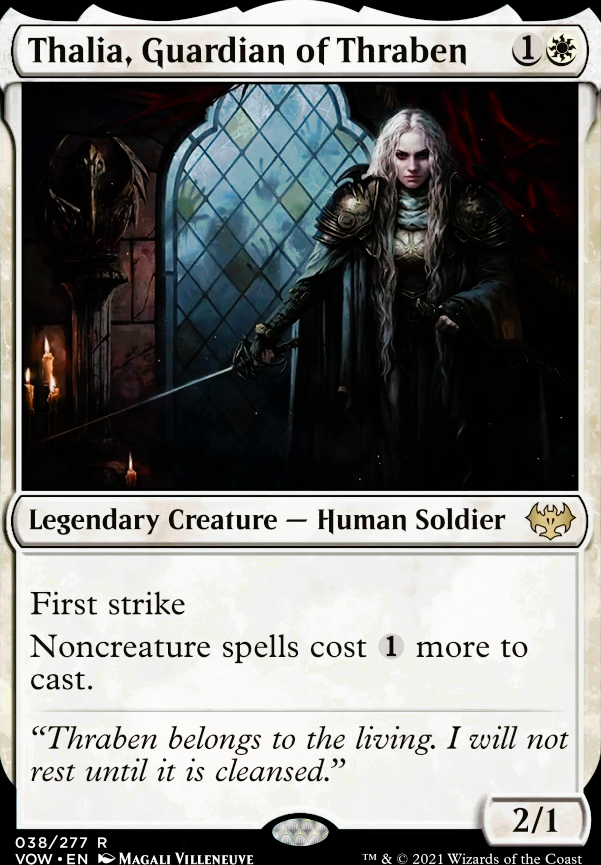"... but in this world nothing can be said to be certain, except death and taxes."
So here is my Legacy deck that's a long time in the making and soon to be sleeved up, completed, and ready to start pimping out! It's my mono-white build of Legacy Death & Taxes, which is nothing new, but arguably the best place to start piloting D&T. Particular credits to Finn, Medea, AntiquatedNotion, and Frenadol over on MTGSalvation for educating me on the archetype and inspiring my brewing!
If you want more in-depth details than I can provide about the history and playstyle of the deck, definitely go check out its long-running thread on MTGS. Given that, I'll go over all the card choices and try to section them out for people unfamiliar with the deck archetype.
Death & Taxes at a Glance:
At a glance, D&T looks sort of like a white weenie deck with some hatebears in it. However, intended playstyle and proper execution are something more akin to a midrange-y control deck. At it's heart, the D&T modus operandi is to disrupt your opponent's mana with Wasteland and
Rishadan Port
, make it difficult for them to use their tools with things like Thalia, Guardian of Thraben and Phyrexian Revoker, and then close the game out with a piece of equipment tutored by a
Stoneforge Mystic
and carried by a flying or evasive creature.
Your goal is to make it so the other deck can't play the game they built their deck to play; make them play your game. And your game is one of slow, gradual beats and the gradual advantage grind. Usually you'll only have one or two creatures on the board, but in certain matchups you go wide and aggressive. Cautious play, staying in control, and knowing your enemy are all key to playing D&T well.
Core Cards:
This is the "see it in every other D&T list" core of my build, very standard with a couple exceptions. Four vials and four StP maindeck are mandatory, but do get sideboarded out sometimes. There are the core creatures of Mom, Thalia, Flickerwisp (which can do so many shenanigans with Vial), Phyrexian Revoker, and SFM. SFM's got the classic equipment suite to draw from depending on what the matchup needs. The land denial suite of Wastes and Ports are there, and lastly three Karakas top it off for combat tricks and rescues for Thalia, and to hose Griselbrand and spaghetti monsters.
Flex Slots:
The debate on exactly how many felx slots D&T has is varied, but for my list I'd say I have bare minimum six that can change between any number of creatures. Mirran Crusaders can be run as anywhere from 0-3 copies, and it serves as a finisher and equipment-carrier in a lot of matchups. I love the creature, so I've got two in case of Elves, Maverick, BUG, etc. Two Serra Avengers round out the flying creature count, and is excellent with vial. They can be bumped up to 3 if needed, if you aren't in a meta that necessitates Crusaders for example. The two Fiend Hunters take a slot that was previously occupied by two Mangara of Corondor. Both serve as additional removal, Mangara being a more general lategame grind to win, and Fiend Hunter being a sword-carrier that is good in creature matchups and can do tricks with Flickerwisp. Plus, Fiend Hunter survives Punishing Fire and blocks well, so I'm trying it out.
Flex Lands:
The last maindeck differences are the lands, which in two of the slots I have Horizon Canopy and Sea Gate Wreckage. Both serve as draw outlets to shore up later game situations, seeing as this deck has no draw other than the one per turn. Granted, you usually play as few cards as possible and sandbag your answers to avoid board wipes, but these can help when needed.
Spicy Sideboard Tech:
D&T is a deck that thrives on meta adaptation and its sideboard, so here's where any splashes or tweaking can really shine. The often-seen Canonists and Containment Priests are there, to hose combo, reanimator, Natural Order, and things of that nature. Council's Judgement is powerful removal tech that also gets rid of TNN's for us. Manriki and SoWaP help in the mirror and against other SFM decks. Pithing Needle is Revoker backup that hits lands, SotL helps hose Elves and blue decks, and Enlightened Tutor acts as a tutor for all of those and more. Lastly, WLL is pretty fun tech against Reality Smashers and decks that back Hymn effects, and outside that it can buff our creatures toughness past 1-2 which counters some g2-3 hate certain decks will side in.

